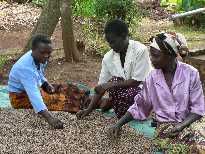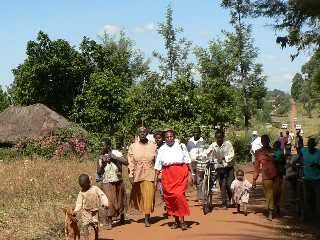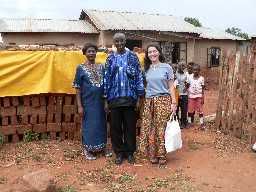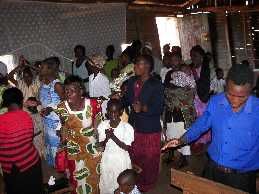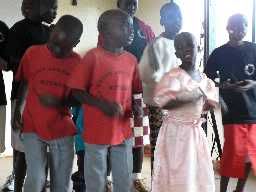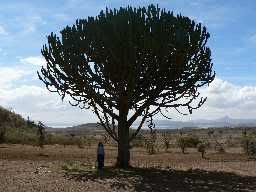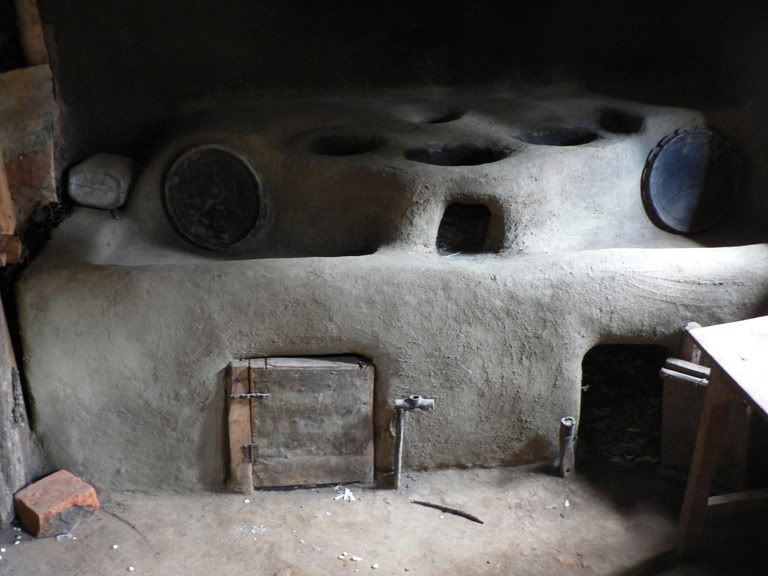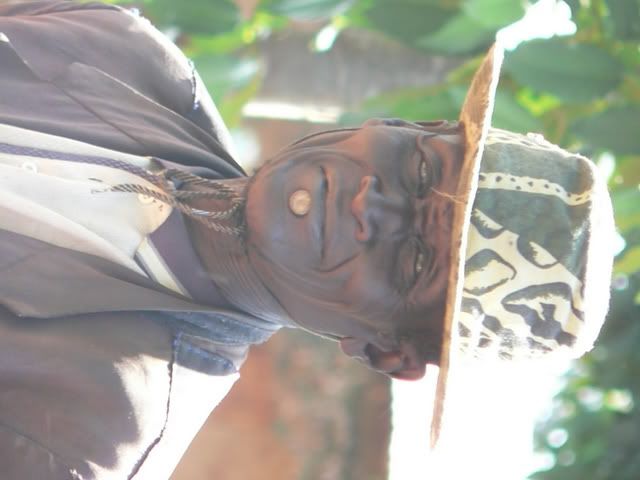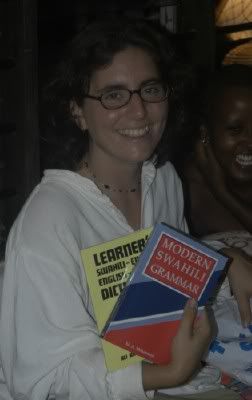written Wednesday, January 11 (then lost for a while, and refound...)
Ahhh... the smells... I have no idea what the smell is
here, but I don't mind it. It's the Kenya smell- or
the Nairobi smell- it hit me as soon as I left the
airport. All of a sudden fractions of so many
memories- all of them pleasant, came back to me. It's
funny how smells can make you remember things, people,
places in time...
And the plants... ooh la la... Bird of Paradise
flowers and bouganveillea bushes everywhere! And all
sorts of succulents- and brilliantly coloured birds
feeding on them all... which reminds me, I must go buy
a bird ID book. I wouldn't mind trying to learn a few
more birds on my own.
After who knows how many hours of travel I am finally
here, in the crowded, chaotic, hilarious city that is
Nairobi. The little mini bus/van (matatu) that
brought me downtown had a screw sticking out of the
steering column 2 inches. Halfway through the ride
the driver noticed a problem with the music system,
and at an intersection rummaged underneath a dust
cloth on the dashboard and came out with a
screwdriver, which he promptly began to stab at the
offending tape player. I can't blame the tape player-
it's more like a 'taped up' player... It makes me
wonder what other sorts of things he keeps his
screwdriver handy for to fix at intersections or in
the stand-still traffic. Everything in these matatus
I've seen today is SO old- upholstery falling apart,
windows cracked or stuck, doors not quite closing,
running boards only half there... I love it... it's
all part of the experience. Ever since the laws came
in that put speed governers on the vehicles and
limited the number of people they can squish in, it is
a much more civilised ride :)
I got picked up from the airport in Nairobi by a
couple who's house I am staying at in a posher
neighbourhood/ community on the outskirts of N'bi
called Karen (named after Karen Blixen, who wrote 'Out
of Africa'). They have a beautiful garden and a great
house which they use as a guest house for travellers
like me connected to ICM, the NGO I'm working with.
From there I took a matatu to the office of A Rocha,
the organisation I came to Kenya with last time.
Although Beatrice, the woman I went to see wasn't
there, I visited with some of the ladies in the office
downstairs who I had gotten to know last time. Mmmmm
two cups of delicious chai later I boarded the matatu
again to go downtown to buy a cell phone. Yay! I
have a mobile phone! I think it will only be for
emergencies though so I won't even give out the
number.
Alright- more later... tomorrow we drive up north to
Kitale.
I can't believe I'm here!
p.s. thanks for all your messages so far... I've been
reading them en route at the Vancouver & London
airports. I'll put up photos as soon as I figure out
how. I don't think I can do it from this particular
cybercafe, for instance.
 How could I forget this photo? The first thing people asked me when I said I was going to Kisumu was: "will you eat fish?" So, on Saturday I ate fish for both lunch AND supper- once at Aggrey's house and once at Salome's. Yum. It's sold 'fresh', pre-cooked in oil, then cooked again in stew at people's houses. This photo is taken at the lake side where we drank sodas together. Surprisingly, fish is fairly expensive so it is not really eaten that much.
How could I forget this photo? The first thing people asked me when I said I was going to Kisumu was: "will you eat fish?" So, on Saturday I ate fish for both lunch AND supper- once at Aggrey's house and once at Salome's. Yum. It's sold 'fresh', pre-cooked in oil, then cooked again in stew at people's houses. This photo is taken at the lake side where we drank sodas together. Surprisingly, fish is fairly expensive so it is not really eaten that much.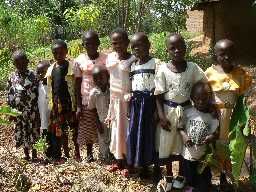 On Sunday I went to four churches. It was a long and exhausting day, because I had to stand up and talk at each of them. Usually I just said my name, where I was from, what I was doing in Kenya, and said I brought greetings from my church in Canada. Then they would clap (receive the greetings), then clap again (send greetings back to Canada). SO warm and welcoming... BUT, I don't love talking in front of big groups when they expect me to say something profound, so it was mildly stressful. Wherever I go people expect me to say something. Whether it's a shamba, a church, or someone's home. Visitors bring blessings to a place... and are believed to have worthwhile things to hear. The best part of Sunday was hanging out with the kids, teaching them a song from home, and having them teach me a new song. They thought it was pretty hilarious watching me trying to follow along to actions of a song that I totally didn't understand the words to. The favourite activity of the kids was having their photo taken and looking at it in the digital monitor. My battery drained pretty fast :)
On Sunday I went to four churches. It was a long and exhausting day, because I had to stand up and talk at each of them. Usually I just said my name, where I was from, what I was doing in Kenya, and said I brought greetings from my church in Canada. Then they would clap (receive the greetings), then clap again (send greetings back to Canada). SO warm and welcoming... BUT, I don't love talking in front of big groups when they expect me to say something profound, so it was mildly stressful. Wherever I go people expect me to say something. Whether it's a shamba, a church, or someone's home. Visitors bring blessings to a place... and are believed to have worthwhile things to hear. The best part of Sunday was hanging out with the kids, teaching them a song from home, and having them teach me a new song. They thought it was pretty hilarious watching me trying to follow along to actions of a song that I totally didn't understand the words to. The favourite activity of the kids was having their photo taken and looking at it in the digital monitor. My battery drained pretty fast :)
 Trees flower so magnificently here. I'm in paradise...
Trees flower so magnificently here. I'm in paradise...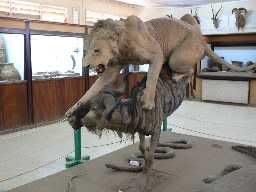
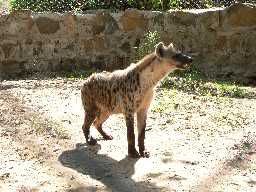 This guy was MUCH more large and powerful than Disney made them out to be!!! I don't believe everything I see in cartoons, but I had no idea this guy was the size of two of me!!! I could almost look at him eye to eye!!
This guy was MUCH more large and powerful than Disney made them out to be!!! I don't believe everything I see in cartoons, but I had no idea this guy was the size of two of me!!! I could almost look at him eye to eye!!
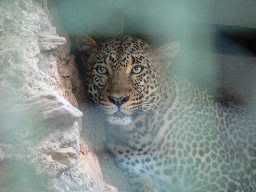 I LOVE the zoom on my camera!! So fun!!! Impala Nature Reserve, Kisumu.
I LOVE the zoom on my camera!! So fun!!! Impala Nature Reserve, Kisumu. 

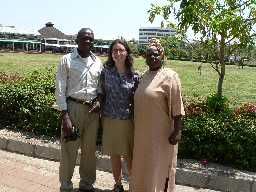 I was so impressed by this park in Kisumu. It could have been in any city in Canada, it was so clean, orderly, and well kept. People have told me that the town of Kisumu is so beautiful (it reminds me of Victoria BC) because the main tribe there is Luo, a people who are known to be fairly prideful and really love the BEST things money can buy (so they can show them off...) :)
I was so impressed by this park in Kisumu. It could have been in any city in Canada, it was so clean, orderly, and well kept. People have told me that the town of Kisumu is so beautiful (it reminds me of Victoria BC) because the main tribe there is Luo, a people who are known to be fairly prideful and really love the BEST things money can buy (so they can show them off...) :)